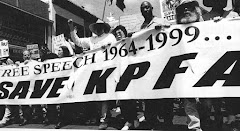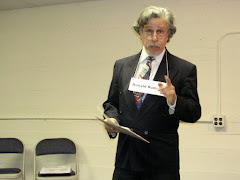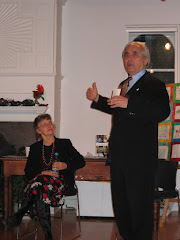On October 2, 2009 Senator Bernie
Sanders made one of his classic fiery speeches on the floor of the US Senate.
This time Vermont's independent socialist was taking on Lockheed Martin and other top military contractors
for what he called “systemic, illegal, and fraudulent behavior, while receiving
hundreds and hundreds of billions of dollars of taxpayer money.”
Among other crimes, Sanders
mentioned how Lockheed had defrauded the government by fraudulently inflating
the cost of several Air Force contracts, lied about the costs when negotiating
contracts for the repairs on US warships, and submitted false invoices for
payment on a multi-billion dollar contract connected to the Titan IV space
launch vehicle program.
A month later, however, he was in
a different mood when he hosted a delegation from Sandia National Laboratories.
Sandia is managed for the Department of Energy by Sandia Inc., a
wholly-owned Lockheed subsidiary. At Sanders’ invitation, the Sandia delegation was in Vermont to talk partnership and scout locations for a satellite
lab. He had been working on the idea since 2008 when he visited Sandia
headquarters in New Mexico.
In January 2010 he took the next
major step – organizing a delegation of Vermonters. The group included Green
Mountain Power CEO Mary Powell; Domenico Grasso, vice president for research at
the University of Vermont; David Blittersdorf, co-founder of NRG Systems and
CEO of Earth Turbines; and Scott Johnston, CEO of the Vermont Energy Investment
Corporation, which runs Efficiency Vermont.
Despite concerns about Lockheed’s
bad corporate behavior Sanders didn’t think that inviting Sandia to
Burlington meant helping the parent corporation to get away with anything. Rather, he envisioned
Vermont transformed “into a real-world lab for the entire nation” through a
partnership. “We're at the beginning of something that could be of
extraordinary significance to Vermont and the rest of the country,” he promised.
When the project was publicly announced
in December 2011, Sanders challenged the description of Lockheed as Sandia’s
“parent company,’ and turned to Sandia Vice President Rick Stulen, who explained that “all
national laboratories” are required to have “an oversight board provided by the
private sector. So, Lockheed Martin does provide oversight, but all of the work
is done by Sandia National Laboratories and we’re careful to put firewalls in
place between the laboratory and Lockheed Martin.”
Gov. Peter Shumlin credited
Sanders for bringing the new multi-million dollar Center for Energy
Transformation and Innovation to the state. Vermont’s junior Senator was “like
a dog with a bone” on the issue, recalled the governor at their joint press
conference. The project, a partnership between Sandia National Laboratories,
the University of Vermont, Green Mountain Power and Vermont businesses, would
create “a revolution in the way we are using power,” Shumlin predicted.
To achieve that, the center has
up to $15 million to accelerate energy efficiency, move toward renewable and
localized sources of energy, and make Vermont “the first state to have
near-universal smart meter installations,” Sanders explained. Sandia will
invest $3 million a year, along with $1 million each from the Department of
Energy and state coffers.
On Nov. 4, Sanders and
Shumlin held another press event, this one in Williston with representatives of IBM, Sandia,
and the US Department of Energy to launch a Vermont Photovoltaic Regional Test
Center. The new center, one of only five
in the country, will research ways to cut the cost of solar power and integrate
solar energy into Vermont’s statewide smart grid.
For Sandia, having a Vermont presence provides “a way to understand all of the challenges that face all states,”
Stulen explained in 2011. Vermont’s size makes it more possible “to get
something done,” he said, revealing that considerable integration had already
occurred with the university, private utilities and other stakeholders.
Vermont’s reputation for energy
innovation also attracted $69.8 million in US Department of Energy funding
to promote rapid statewide conversion to smart grid technology. This is being matched, according to Sanders, by another $69 million from Vermont utilities.
Flying High: How Lockheed Happened
Lockheed Martin is one of the top
US government contractors, bringing in $36 billion in 2008. That’s roughly $260
per household, known in some parts of the country as the Lockheed Martin Tax.
It is also a top US weapons contractor (about 80% of its revenue comes from the
Pentagon), as well as high among Departments of Energy and Transportation
contractors, and in the top five with the Department of State, NASA,and the Departments of Justice and Housing and Urban Development.
Beyond producing planes, subs and
weapons systems it has supplied interrogators for the prison at Guantanamo Bay,
trained police in Haiti, run a postal service in the Congo, and helped write
the Afghan constitution. In the US, it has helped to scan mail, design and run
the Census, process taxes for the IRS, provide biometric ID devices for the
FBI, and played a role in building ships and communication equipment for the
Coast Guard. Its more than 100,000 employees have a presence in 46 states.
Despite – or, maybe because
of – its scope and size, however, Lockheed executives sometimes feel the need
to violate rules. As a result, as Bernie Sanders often mentioned in speeches
until a Sandia lab for Vermont took shape, it is also number one in contractor
misconduct. Between 1995 and 2010 it engaged in at least 50 instances of
misconduct and paid $577 million in fines and settlements.
In the mid-1990s
then-Rep. Sanders objected to $91 million in bonuses for Lockheed-Martin
executives after the defense contractor laid off 17,000 workers. Calling it “payoffs for layoffs” he succeeded
in getting some of that money back.
The corporation has come a long
way from its beginnings before the First World War. Two brothers, Allen Haines
and Malcolm Loughead, formed their first aircraft company in 1916, after
building a plane a few years earlier. When their charter service foundered,
they turned to government work with plans for a “flying boat” known as the F-1.
The Navy passed and the plane was used only for flight demonstrations, but the
brothers managed to survive in business by marketing tourist flights.
A decade after the war they
incorporated Lockheed Aircraft Corp. in Nevada. Its first plane, the Vega, made
possible explorer George Wilkins’ first flight over the Arctic Circle. Due
largely to the publicity surrounding that event Lockheed’s stock value rose
fast enough at the end of the 1920s to make it an attractive takeover target.
It soon became part of Detroit Aircraft, then touted as “the General Motors
of the Air.” Detroit Aircraft went belly up within a few years, however, and
Lockheed was purchased by a group of investors for only $40,000. By 1935 it was
back in the black, bringing in more than $2 million in sales.
Even before World War II most of
its planes were being built for the military, at home and abroad. Britain had
purchased 1,700 by 1941. The scale of the UK deal, along with the 10,000
twin-engine fighter planes it subsequently sold to the US during the war,
turned it into the largest company in the industry.
Although Lockheed also produced
commercial airplanes – notably the Constellation, used by TWA and Pan Am –
after WWII its bread and butter became fighter planes and patrol aircraft for
the Air Force and Navy. It was simple math. Post-war military sales to the
government averaged about ten times the sales to airlines.
Lockheed succeeded in part by
equating its own interests with the national interest. During the Cold War the
rationale wasn’t just competition with the Soviet Union but also building up
the exciting aeronautics industry, keeping skilled personnel, and promoting
jobs directly and through various vendors. All this required long-term planning
and sustained government funding. The US had a global responsibility, argued
Lockheed’s executives, and that meant rapid transport of people, food, energy
and weapons.
The development of its C-5A
Galaxy – a Vietnam-era, over-sized transport craft with a 223-foot wingspan –
illustrates the company’s actual approach to partnership with the government.
At first, they submitted low bids and talked about the national interest. By
the time the project was close to delivery, however, the price was up by
billions, plus a steady income for years to come supplying replacement parts
--at open-ended prices. With the only real downside the risk of a small fine if
they broke the rules, it was well worth the price.
The SEC later found that Lockheed
and the Air Force concealed the overruns, and Lockheed executives sold off
their own stocks while withholding information from shareholders. As Rep. Otis
Pike recalled, the C-5A scandal illustrated Lockheed’s sales tactics. Once
government buys in and the overruns begin, “they make up their hole by laying
it on the spare parts. There’s not a damned thing the Air Force can do about
it…Once they start buying equipment, they have to get their spare parts.”
As the industry evolved, adding
missiles, exotic aircraft and space vehicles, Lockheed was at the forefront
with its Polaris missile and high-tech spy planes for the CIA. The most famous
was the U-2, a fast, high altitude aircraft that was top secret until one was
shot down. The real important of the U-2 was that it revealed the exaggeration
of Soviet military might. But few people were allowed to see what the U-2
photos actually proved. Instead military spending hit a new high to combat the
alleged threat.
Beginning the 1990s Lockheed was
a winner in the long-term effort to privatize government services. In 2000, it
won a $43.8 million contract to run the Defense Civilian Personnel Data System,
one of the largest human resources systems in the world. As a result, a major
defense contractor consolidated all Department of Defense personnel systems,
covering hiring and firing for about 750,000 civilian employees. This put the contractor
at the cutting edge of Defense Department planning, and made it a key
gatekeeper at the revolving door between the US military and private interests.
For the past decade Lockheed’s
largest project has been the F-35 Joint Strike Fighter, the largest project in
the history of military aviation. One Lockheed executive has called it “the
Super Bowl” and the “program of the century.” Early plans called for the US and
Britain to buy more than 3,000 planes.
The initial idea was to create a
capable plane without the performance problems that had plagued earlier
efforts. But as the R & D proceeded, various capabilities and requests
collided. The Navy version turned out to be seriously overweight. National
partners meanwhile quibbled over who should get what lucrative production work.
One faction in the military publicly criticized the plane, especially the idea
of its so-called “multi-role.”
Maintenance and support would carry a high price
tag – $700 million over the lifetime of a plane. The engines reportedly
ran so hot that they could melt the decks of aircraft carriers on vertical
takeoff and fatigue the metal beneath.
On October 28, the Burlington
City Council defeated two resolutions that would have opposed a proposal to
base F-35s at the Burlington International Airport. The first was
designed to block the F-35s from the Vermont Air National Guard facility at the
airport. The second would have created "health and safety standards"
applying to all planes.
The votes were the latest in a
series by communities near the airport on whether to support bedding the
planes in Vermont. In South Burlington, councilors
earlier this year voted in favor of the F-35, reversing an earlier
decision. In July, the Winooski City Council voted to oppose the basing plan.
Strange Bedfellows: Sandia and the Senator
Most of the revenue for
Lockheed’s Sandia National Laboratory comes from maintaining nuclear weapons
and assessing defense systems. Its primary headquarters is on Kirtland Air
Force Base in Albuquerque, NM, and employed about 7,500 people. The other is in
Livermore, CA, employing another 1,000. If the Pentagon ever decides to make
the F-35 capable of dropping nuclear bombs, not an impossible development,
Sandia is very likely where it will be made.
But not at the Vermont lab. Bernie
Sanders has repeatedly pledged that Vermont’s facility will strictly avoid
defense work. Instead, it will focus on energy technology and cyber-security
issues, and examine "how to bring these technologies to bear and to use Vermont
as a test bed," explained Les Shephard, Sandia's vice president for
energy, resources and nonproliferation. To do that, Shephard added, the Vermont
satellite lab will have access to Sandia resources to develop
innovations that could, ideally, be spun off into new companies.
Some resulting enterprises might
even be based in Vermont.
The state was appealing, according
to Shephard, because it was already "a national leader" in energy
efficiency. But it was also small enough to serve as a manageable site for a
variety of experiments. At around $20 billion Vermont’s total GDP is less than
half of what Lockheed makes in a year.
In addition to Vermont’s
reputation for energy efficiency and “cooperative utilities,” Sandia also
appreciates the region’s challenging climate. "We could develop, deploy
and assess various types of technology in cold weather," Shephard
explained. "Our test facilities are in the bright skies of New
Mexico, where we have over 300 days of sunshine."
Another stated focus of the
center is to ensure reliable service. That means “anticipating any cyber
challenges that may be opened up, or vulnerabilities that may be opened up as
we move to this new future,” Stulen said. “Sandia is very much in the forefront
of cyber research.”
Joint efforts between Green
Mountain Power and Sandia began at least two years ago. The long-term goal is
to make Vermont “a national example of how to deploy smart grid technology
across a state, along with renewable generation and really demonstrate that we
can handle the security issues that come with that.” notes Mary Powell, Green
Mountain Power’s CEO.
One of those issues is that
having numerous interactive devices on two-way networks creates new risks.
According to Kenneth van Meter, manager of energy and cyber services for
Lockheed Martin, “By the end of 2015 we will have 440 million new hackable
points on the grid. Nobody’s equipped to deal with that today.” Asked about
cyber threats, Stulen has acknowledged that use of “more portals” creates more
potential threats, but adds that “we think this is a manageable situation. In
fact, the benefits far outweigh the risks.”
In the category of benefits,
Stulen points to the potential for lower utilities bills by being able to
monitor home energy use in detail. But security is also a focus. “We don’t see it as an
overriding issue right now, but as a national laboratory our job is to
anticipate the future,” he said.
“The federal government has
invested $4 billion in smart grid technology,” Sanders notes, “and they
want to know that we’re going to work out some of the problems as other states
follow us. So Vermont, in a sense, becomes a resource for other states to learn
how to do it, how to overcome problems that may arise.
“In many ways, we are a
laboratory for the rest of this country in this area,” Sanders adds. To that
end, an exchange program was launched between Sandia and the University of
Vermont in 2011, with nine students and several faculty members working on
smart grid-related project. The center also began offering short courses on
smart grid modernization for Vermont utility staff and energy-tech company
management.
Earlier the same year, however, a
dispute erupted over a related development agreement between the City of Burlington and
Lockheed Martin. After months of study and debate, the City Council adopted a
community standards resolution, largely in response to public criticism of the
deal with Lockheed signed by Progressive Mayor Bob Kiss.
Kiss vetoed the Council's resolution. But three
weeks later, Rob Fuller, a spokesman for Lockheed, said the deal
was off. "While several projects showed promise initially and we have
learned a tremendous amount from each other," he wrote, "we were unable to develop a
mutually beneficial implementation plan. Therefore Lockheed Martin has decided
to conclude the current collaboration."
It read like a Dear John, and a
silent bow to public pressure.
Sensitive to local criticisms of
Lockheed and the F-35, Sanders bristles at the description of the
corporation as “a parent company” of Sandia, which was founded in 1949 and has
roots in the development of the atomic bomb during World War II. The company’s
website describes its work during that period as “ordnance engineering,” which
involved turning the nuclear innovations of the Los Alamos and Lawrence
Livermore labs into functioning weapons.
Revenue figures indicate that most
of Sandia’s revenue continues to come from maintaining nuclear weapons and
assessing defense systems. Its primary headquarters is on Kirtland Air Force
Base in Albuquerque, NM, where about 7,500 people are employed. The other big
lab is in Livermore, CA, employing another 1,000. Known in the past as a
“national security lab,” Sandia’s 21st century mission has expanded to include
“security of the smart grid.”
A statement by Sanders released
at the 2011 press conference stressed that although the US has 17 national labs
doing “cutting edge research,” none of them were located in New England. That
was what he hoped to change after visiting Sandia’s New Mexico headquarters back
in 2008.
“At the end of the day,” recalled
Les Shephard, “he turned to the laboratory director and said, ‘I’d really like to have a set
of capabilities like Sandia in New England — and very much so in Vermont.’ And
that’s how it all evolved.”
“It occurred to me,” Sanders
recalled later, “that we have the potential to establish a very strong and
positive relationship with Sandia here in the State of Vermont.” His hope is to
make the current thee-year arrangement “a long-term presence” between the lab,
UVM, utilities and other businesses.
“This is a really exciting
development for Vermont,” said Shumlin, calling the partnership “a huge
opportunity and a huge accomplishment.”
Sanders added that “working with
Sandia and their wide areas of knowledge – some of the best scientists in the
country – we hope to take a state that is already a leader in some of these
areas even further.” Lockheed’s past offenses didn't come up.

































No comments:
Post a Comment